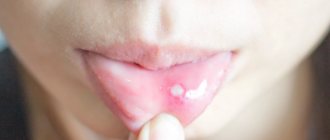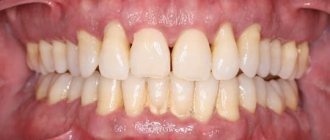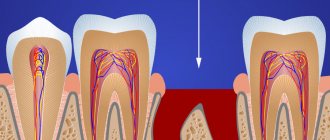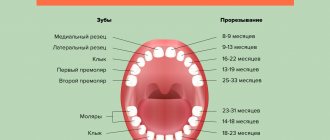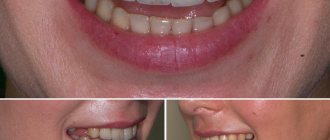Posted by Marbery Gedrean | Checked by: Shteba Victoria Petrovna | Last revised: October 18, 2021.
Most parents are very concerned about how teething (and gums) affects their babies in everyday life. Although we cannot fully predict exactly how each baby will react to their first tooth. However, we can learn about teething symptoms and how to calm your baby during this difficult time. Overall, the more we know about teething, the better we can help our babies survive it. Let's figure it out.
Formation of permanent teeth
Molars are formed from the epithelial dental plate. The appearance of their rudiments occurs only closer to the 5th month of fetal development inside the mother’s womb.
There are two groups of molars:
- Substitutes. This includes canines, incisors and premolars, which have temporary analogues.
- Additional. This group includes molars that do not have milk predecessors.
The growth of the primordial teeth of the replacement type occurs in the same alveolus as the temporary teeth; they are located behind the lingual surface of the primary teeth. Only after some time does the volume of bone tissue increase, ensuring their insulation.
Additional teeth are formed only after a year, since for this the jaw must reach the appropriate size.
How to relieve pain when wisdom teeth erupt
To reduce pain and swelling, you can massage the gum with your finger or apply a piece of ice to it. Hands must be thoroughly washed and disinfected. The gums need to be massaged gently, in a circular motion; you should not rub too hard, otherwise you can damage it and cause bleeding. Massage is not done if pus is secreted from under the “gum hood”, otherwise the infection can spread to the bone and periodontium.
Ice can be applied up to 5 times a day for a few minutes. The cold causes the tissues to become numb, and the pain decreases for a short time. Peppermint candies also help.
If the gums have become loose and the figure eight has partially erupted, you should:
- Chew on the healthy side so that food does not accidentally fall under the “hood”;
- Avoid hot and spicy foods, which irritate the mucous membranes and increase pain;
- Carefully monitor oral hygiene to prevent pericoronitis;
- Rinse your mouth with antiseptics or infusions of sage and chamomile.
You cannot remove food particles with your fingernail, injure the mucous membrane with a toothbrush, or try to “speed up” tooth eruption with hot compresses.
For severe pain, you can take a painkiller orally or use gels. If the swelling and pain intensify, the body temperature rises, and the third molar does not erupt, contact your dentist. He will examine the oral cavity, take an x-ray and prescribe painkillers and anti-inflammatory drugs. In case of pericoronitis, it is enough to cut off the gingival hood so that the “eight” takes its correct position in the dentition. In difficult cases, the dentist will recommend removing the wisdom tooth.
At what age do they appear?
Statistics show that the beginning and completion of the change from temporary teeth to molars in most children occurs at approximately the same time. There are minimal differences only among children in different regions. The warmer the climate, the sooner the child will have permanent teeth.
The table shows age parameters that can be used to determine the approximate beginning of the eruption of molars according to several well-known authors.
| Set of teeth | Period of eruption of permanent teeth in children (in years) | ||
| according to Vinogradova | according to Lukomsky | according to Novak | |
| Central incisors | 5-6 | 6-9 | 6-9 |
| Lateral incisors | 7-9 | 7-10 | 7-10 |
| Fangs | 12-13 | 9-14 | 9-14 |
| First premolars | 9-11 | 9-13 | 9-13 |
| Second premolars | 9-11 | 9-15 | 10-14 |
| First molars | 4,5-7 | 7-8 | 5-8 |
| Second molars | 12-13 | 10-15 | 10-14 |
| Third molars | 18-25 | 15-24 | 18-20 |
The differences in the age at which permanent teeth appear depending on the author are due to the fact that they present the results of studies in different regions that were carried out with a serious difference in time (several decades).
How long does it take for infants to erupt teeth?
A common question among new parents is: how long does it take for a baby to teethe? Despite the fact that modern medicine uses advanced equipment and fresh scientific discoveries, no doctor can predict how long it takes for infants to erupt their first teeth. Each baby will begin to develop teeth at different times. This is a highly individual process that is influenced by many factors. If you notice slight redness and swelling of the gums, it means that the first tooth will appear within one week to two months. It will take the tooth 3 to 7 days to break through the gum. The teething process is accompanied by discomfort and pain. While the tooth passes through the tissue, the baby feels unpleasant itching and pain.
Inflamed gums can also bother a child. Complications often arise due to infection. During this period, parents should pay close attention to the child’s condition. How long it takes for children to cut teeth depends solely on the individual characteristics of the baby’s body. Since the upper teeth take a long time to erupt, children will have the hardest time and the most pain when the canines of the upper jaw erupt. Remember, no matter how much you would like to help your child, under no circumstances should you give infants adult painkillers. The content of active substances in high concentrations causes allergic reactions and other serious side effects in children. To ensure that everything goes as painlessly and safely as possible for the baby, you should consult a pediatrician.
Teething sequence
Almost all parents believe that the first molars should be incisors, which replace temporary elements of the dentition. But this opinion is wrong. Even before baby teeth fall out, at the age of 5-6 years, children receive their first molars, which are not on the list of primary teeth.
After this, the sequence of formation of a permanent bite is almost no different from the order of eruption of primary teeth:
- the lower and upper central incisors grow;
- lateral incisors appear on both jaws;
- lower and upper first premolars;
- fangs;
- upper and lower second premolars;
- second and third molars (you must understand that the so-called “wisdom teeth” sometimes do not penetrate the surface of the gums at all).
Teeth cutting in this order does not happen just like that, because it ideally corresponds to the speed of development and formation of the maxillofacial system. If the optimal sequence is followed, correct bite development occurs.
How to know if a wisdom tooth is coming out
A wisdom tooth or “eight” is a third molar that erupts on both sides of both jaws at 16-30 years of age.
Because this age is considered mature, and the third molar is the last one to grow in the jaw, it is called a “wisdom tooth.” Some dentists consider the “eight” to be a vestige, that is, an organ that has lost its significance in the course of evolution. Primitive man needed it to chew rough plant foods - nuts, grains and leaves.
Modern man eats soft food that has undergone culinary processing, so the jaw has become 10-12 cm smaller, and the dental system has been rebuilt. As a result, in 76% of people, the third molar does not erupt, remaining in the bone socket, or grows partially or incorrectly.
From the article on Stom-Firms.ru you will learn how a wisdom tooth grows, why it is difficult for it to erupt and what symptoms arise.
Duration of growth
Typically, children say goodbye to their last temporary teeth at about 12-13 years of age, although the roots of baby teeth dissolve even earlier. By that time, the oral cavity already has molars that are actively growing, and their roots are at different stages of formation.
It is necessary to understand the approximate timing of growth and root formation in case of deviations. It is these indicators that are taken into account when choosing a treatment method.
Experts distinguish two main stages of development of the roots of permanent teeth:
- Stage of unformed apex.
- Unclosed apex stage.
At the first stage, the length of the root becomes maximum, but its walls are parallel to each other. The channel is of sufficient width; it ends in the area of the future apex with a bell. The periodontal gap can be seen only on the sides of the tooth root.
At the next stage, there is a gradual formation of the upper part of the root, the convergence of the root walls and the release of the periodontal fissure, the apical region of which is slightly enlarged.
How long does it take for wisdom teeth to erupt?
The rudiments of “eights” can be detected as early as 3 years. During adolescence, when the jaw is actively growing, roots form. Normally, teething lasts 3-5 months, while unpleasant sensations may disappear and reappear.
The rate of growth depends on both local and general reasons, which we have collected in a table. The listed reasons, on the one hand, slow down eruption, and on the other hand, they disrupt the ratio of the sizes of the jaw and wisdom teeth.
| General factors | Local factors |
|
|
During puberty and pregnancy, the body releases many substances - cell growth factors. They act on G8 stem cells and stimulate its formation and growth.
The completion of tooth root formation occurs at approximately this age:
| Teeth | Upper jaw, age | Lower jaw, age |
| Central incisors | 9-13 | 7-11 |
| Lateral incisors | 9-12 | 8-11 |
| Fangs | 9-12 | 9-12 |
| First premolars | 11-13 | 11-13 |
| Second premolars | 11-13 | 11-13 |
| First molars | 9-12 | 9-12 |
| Second molars | 14-15 | 14-15 |
Since the eruption of third molars does not occur at a specific time, it is impossible to establish a clear age at which their roots are formed.
X-ray results confirm the completion of the process of tooth root formation. The key signs are the absence of an opening at the apex, as well as a pronounced periodontal contour.
Thus, completion of dental growth, including full maturation, usually occurs only between the ages of 15 and 18 years. It is at this time that the maxillofacial apparatus already has the same dimensions as in adults.
How to understand that a wisdom tooth is cutting?
For many, “eights” erupt without causing complaints. But since the sharp edges of the crown irritate the nerve endings of the gums, the following symptoms occur:
- Soreness or dull throbbing pain;
- Swelling of the gums, which can be felt with the tongue;
- Saliva mixed with blood;
- “Gum hood”, that is, raised gum above the crown of the tooth.
The pain intensifies when a person chews, opens his mouth, or lies down. In people with a low pain threshold, it can be severe, even if the tooth grows correctly and does not encounter obstacles.
If the third molar cannot “break through” the soft tissue, pericoronitis occurs - inflammation of the gum above the crown. The tooth injures the mucous membrane, tears form in it, in which food particles and bacteria accumulate, causing inflammation. Pus forms under the “gum hood” and can be released into the oral cavity.
If pus spreads to the periodontal tissues and bone, periostitis occurs - a flux that causes the following symptoms:
- The mucous membrane becomes cyanotic;
- The cheek is swollen;
- The pain becomes unbearable and intensifies when you try to open your mouth;
- The patient cannot eat;
- The parotid and submandibular lymph nodes are enlarged;
- Body temperature rises to 38°C.
When the swelling spreads to the cheek, palate and throat, the patient experiences difficulty swallowing. Severe pain is disturbing if the “eight” does not fit in the jaw, grows at an angle, or displaces and compresses the neighboring tooth, the “seven”. Because of this, the bite may change, and caries may appear on the neighboring “seven”.
What mistakes should not be made?
Every caring mother and attentive father strive with all their might to make it easier for the child to survive the teething process. But sometimes panic forces adults to make serious mistakes. Below we will look at what you should absolutely not do:
- Cool the gums too often. Cold helps, but you should not constantly be exposed to cold, as this can cause the development of a cold.
- Do not give babies crackers, refined sugar and other foods that can scratch the mucous membranes. You can prepare a chilled teether for your baby.
- Soda solution instead of gels. Don't experiment. It is better to consult a pediatrician who will recommend the optimal dental gel.
It is difficult to say for sure how long it takes for babies to erupt teeth. But parents during this period should be prepared for any turn of events.





